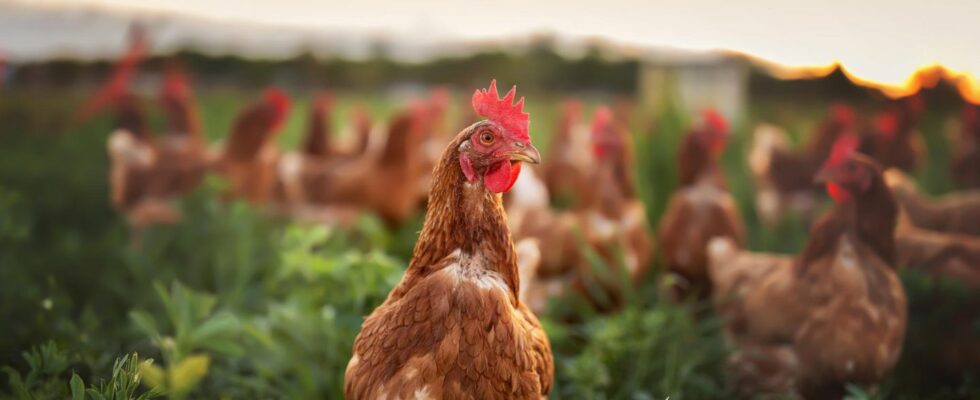Stefanie Laab
Stefanie Laab saves laying hens in her free time
More than two dozen rescued chickens flutter around in Stefanie Laab’s garden.
© Jacqueline Anders / Adobe Stock
Her profession: elementary school teacher
Her hobby: saving chickens
Your opinion on breakfast eggs: no, thank you!
As a child, Stefanie Laab was unfamiliar with chickens. She spent a lot of time with her grandparents on a farm, but while most animals found a place in her heart, she barely noticed chickens. “I couldn’t tell them apart and didn’t dare pet them,” she says. Today the 49-year-old primary school teacher is the chairwoman of the “Save the Chicken” association. She lives near Wolfsburg and keeps 26 chickens in her garden, which she knows by name and many of which eat out of her hand and even sit on her lap. “It’s so touching when a chicken makes contact,” she says. The laying hens that come from factory farming are particularly trusting.
Stefanie Laab and the club members rescue chickens from commercial laying hen farms with different types of farming: barn farming, free-range farming and organic farming. Barn farming, which accounts for around 60 percent of the egg industry, means that the eggs are bred to peak performance Tens of thousands of laying hens live in a three-story metal tier system in halls without daylight. They lay around 300 eggs a year, many of which are painful because they suffer from inflamed egg intestines. They injure themselves on conveyor belts, break their legs, are constantly stressed and pull out other chickens’ feathers because they live in groups that are too large and their disturbed natural hierarchy struggles lead to unnatural cannibalism. “Some are naked as chickens,” says Stefanie Laab. She cried when she saw such a business for the first time: “It stank, it was loud and so incredibly narrow. The reality was worse than the images in my head.”
The animal rights activist explains that the conditions are not only unacceptable in barn farming, but there are also deficiencies in organic farming. A maximum of six chickens lived there per square meter (instead of nine in barn systems), but permitted group sizes of up to 3,000 animals were not species-appropriate. Chickens also injured each other in such houses. “There should be a maximum of 50 animals per group,” says Laab.
Stefanie’s passion: saving chickens
In all types of farming, laying hens are considered unprofitable if their performance declines. They are slaughtered after around a year and replaced with young animals. This is when “Save the Chicken” takes action. The association cooperates with companies that allow it to have stables. To do this, he set up a nationwide aid system. The laying hens are carried out of the stables in full protective clothing, injured animals are cared for on site by veterinary specialists and transportable hens are handed over to those people who have agreed to keep them in a species-appropriate manner in the future. 12,000 chickens are saved every year.
Laab came across “Save the Chicken” in 2012, which was still a small private initiative at the time. The founder, Katja Tiepelmann, happened to see an exhibition in her village and asked the farmer if she could take over some of the chickens, which she then passed on to people in her circle of friends and acquaintances. She continued and the initiative grew. Stefanie Laab initially just wanted a few chickens for her garden and joined “Save the Chicken”: “I’ve always had a heart for animals. I adopted dogs and cats. But with Chicken Rescuers I found a way to do something about factory farming. I can’t ignore this horror.”
She started as an animal agent for Lower Saxony, took on more and more tasks in the overall organization and became chairwoman of the board when the club was founded in 2015. Since then, “Save the Chicken” has not only become larger and more professional, but also much better known. Stefanie Laab gives interviews, appears on talk shows, and writes the texts on the website. She knows: “Save the Chicken” won’t change the system, it’s too powerful for that. 20 billion eggs are consumed in Germany every year, one in four of which are found in pasta or biscuits without any obligation to label the type of egg kept. If you really want to make a change, you should only buy eggs where the chickens are raised in a species-appropriate manner, or avoid them altogether. Stefanie Laab has been vegan for many years and doesn’t miss a single egg.
